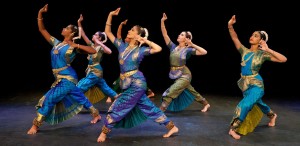Landowners and city officials commissioned nine-year-old Malathi Iyengar to decorate the entryways of the temples and festival halls in Bangalore, India with bright patterns made of colored flour, grains of rice and flower petals.
To Iyengar, creating the designs, known as rangolis, was much more than just a hobby – the rangoli was a powerful symbol of her Indian heritage. It would later serve as the image for her own Indian classical dance company.
“(Rangoli) represented how old traditions pass from elderly people, neighbors and my mother to me, as a daughter,” said Iyengar, a UCLA alumna and the founder and artistic director of Rangoli Dance Company.
Iyengar hosted a short dance program Sunday as part of the Fowler Museum Summer Concert on the Green series. The program, which featured seven dancers from the company, also paid tribute to Rangoli’s 30 years of growth as a school of South Indian classical dance, or Bharatanatyam, as well as Indian culture.
Bharatanatyam typically involves rigorous technique, facial expressions and hand gestures conveying certain stories and dialogues, Iyengar said. The choreography is accompanied by classical lyrics and music revolving mainly around religious themes. Dancers wear heavy gold temple jewelry and fitted, brightly-colored costumes.
Over the past 30 years, Iyengar said a devotion to Indian visual art laid the foundation for her love of Bharatanatyam. Iyengar founded Rangoli Dance Company in 1985 after working with the Los Angeles Unified School District as an art teacher for five years.
At LAUSD, Iyengar said she tried to expose American children to aspects of Indian culture such as how to dance and sing cultural pieces, tie traditional saris and create small rangoli works.
However, during that time, Iyengar said she realized her own hunger to learn more about Indian classical dance had grown. For Iyengar, dance, like rangoli, was a strongly visual medium to portray the spirit, culture and heritage of India.
Twice a year from 1988 to 1989, Iyengar sponsored her childhood Bharatanatyam teacher, called a guru, to travel from Bangalore, India to teach her and her daughter Lakshmi in the United States. During that period, the mother-daughter duo flew back to India once a year to perform and gain more experience.
Iyengar said ultimately, dance became her only focus.

Iyengar later decided to apply to the MFA program in Dance with an emphasis in choreography at UCLA to gain more experience in stage techniques and was the first admitted student to come from a traditional dance background. At the time, Iyengar said the department had only worked with modern and ballet dancers in the choreography program.
Her mentor at UCLA was Marion Scott, a professor emeritus and choreographer of modern dance. Iyengar said the department recalled Scott from retirement because of Scott’s experience working with dances from other cultures such as Indonesian dance and flamenco.
Iyengar said Scott’s method of teaching allowed her to find her own creative process.
“(Scott) taught by asking questions, rather than providing any answers,” Iyengar said. “(Classes) involved a lot of self-introspection and going deeper into the main point of the choreography, the intent.”
Lakshmi Iyengar, a dance company member and Malathi Iyengar’s daughter, said her mother’s experiences in stage production, choreography and both the eastern and western traditions of dance bridge the gap between the Bharatanatyam and modern dance cultures.
In her current productions with Rangoli, Malathi Iyengar said she uses techniques gained during her exposure to modern choreography, such as her training in staging and lighting, to make the experience more enjoyable for both dancers and the audience.
Because Bharatanatyam dancers can perform in groups, Akshaya Sekhar, a company dancer, cited the importance of staying together on the beat. This was a challenge in the Fowler performance, Sekhar said, because the sounds disappeared into the outdoor air on the Fowler grounds.
“If you can’t hear the music properly, you’re not going to be able to perform to the utmost capability, ” Sekhar said. “Nevertheless, (performing) outdoors is nice because it gives a more interactive feeling than in an auditorium.”
Regardless of style, however, Iyengar said the main goal of her teaching is for her dancers to convey devotion and enjoyment to the audience.
“I hope to see a connection between the performer and the perceiver,” Iyengar said. “If the audience receives an element of spirituality, that’s enough.”
